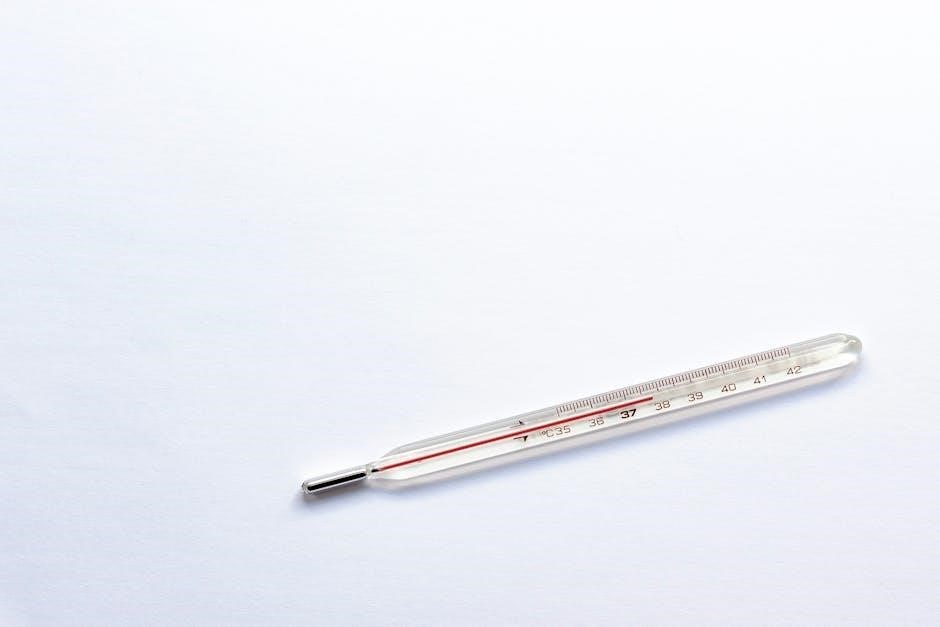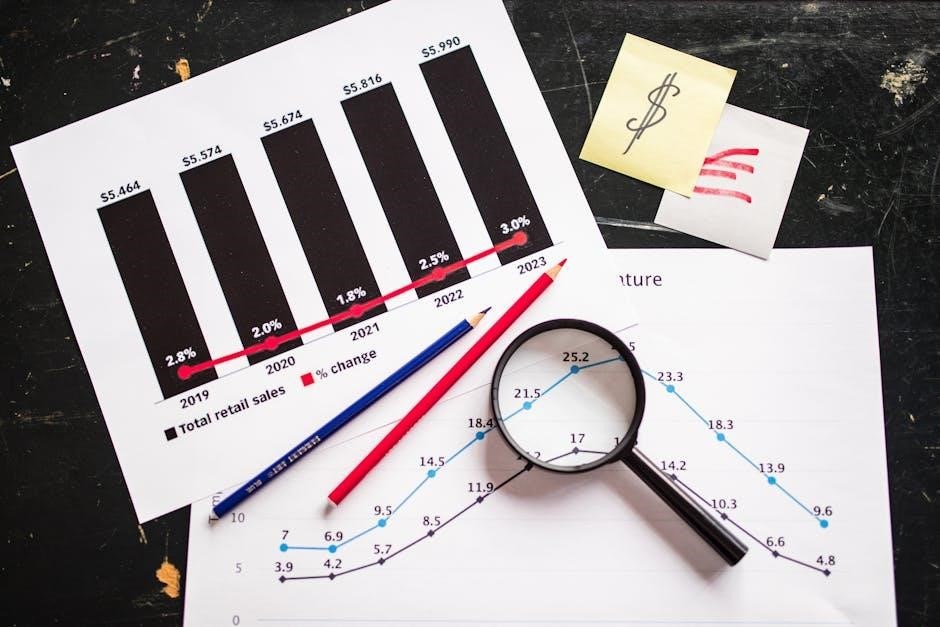Understanding Celsius to Fahrenheit conversion is essential for various scientific, culinary, and everyday applications. This guide provides a straightforward method to convert temperatures accurately using a handy chart.
1.1 Importance of Temperature Conversion
Temperature conversion is crucial for scientific research, cooking, and weather forecasting. Accurate conversions ensure consistency in global communication, especially in recipes, climate data, and industrial processes. A Celsius to Fahrenheit chart provides a quick reference, simplifying everyday tasks and enhancing precision in diverse applications.
1.2 Brief History of Celsius and Fahrenheit Scales
The Celsius scale, created by Anders Celsius in 1742, is based on water’s freezing and boiling points. Fahrenheit, developed by Gabriel Fahrenheit in 1724, uses a different reference point. Both scales remain vital today, with conversion charts like the Celsius to Fahrenheit PDF bridging the gap for modern applications.

Understanding the Celsius and Fahrenheit Scales
The Celsius scale defines 0°C as water’s freezing point and 100°C as its boiling point. Fahrenheit sets water’s freeze at 32°F and boil at 212°F, differing in intervals and reference points.
2.1 Definition of the Celsius Scale
The Celsius scale is an interval-based temperature system where 0°C represents water’s freezing point and 100°C its boiling point at standard atmospheric pressure. Developed by Anders Celsius, it is widely used globally for scientific and everyday measurements, offering a logical and intuitive framework for temperature assessment and conversion purposes effectively.
2.2 Definition of the Fahrenheit Scale
The Fahrenheit scale, created by Gabriel Fahrenheit, defines water’s freezing point at 32°F and boiling point at 212°F. It is commonly used in the United States and offers precise temperature gradations, making it suitable for specific industrial and weather-related applications, though less intuitive for international scientific use compared to Celsius.
2.3 Key Differences Between the Two Scales
The Celsius and Fahrenheit scales differ in their reference points and degree intervals. Celsius uses water’s freezing at 0°C and boiling at 100°C, while Fahrenheit sets these at 32°F and 212°F. Each Celsius degree equals 1.8 Fahrenheit degrees, making Celsius more standardized for international science, while Fahrenheit remains prevalent in the U.S. for everyday use.

Conversion Formulas
The formulas for temperature conversion are essential for accurate results. Use °F = (°C × 1.8) + 32 to convert Celsius to Fahrenheit and °C = (°F ‒ 32) / 1.8 for the reverse conversion. These formulas ensure precision and are widely used in various fields.
3.1 Celsius to Fahrenheit Formula
The Celsius to Fahrenheit formula is °F = (°C × 1.8) + 32. This formula allows for accurate conversion of temperatures from Celsius to Fahrenheit. For example, 0°C equals 32°F, and 100°C equals 212°F. Using this formula ensures precise temperature conversion for various applications, including cooking, weather forecasting, and scientific research.
3.2 Fahrenheit to Celsius Formula
The Fahrenheit to Celsius formula is °C = (°F ౼ 32) ÷ 1.8. This formula enables precise conversion of temperatures from Fahrenheit to Celsius. For instance, 32°F equals 0°C, and 212°F equals 100°C. Utilizing this formula ensures accurate temperature conversion for various applications, including weather forecasting, cooking, and scientific research.

Celsius to Fahrenheit Conversion Chart
This comprehensive chart provides a quick reference for converting temperatures from Celsius to Fahrenheit, covering a wide range from -50°C to 225°C in 5°C increments.
4;1 Sample Conversion Table
A sample conversion table is provided below, showcasing common temperature conversions from Celsius to Fahrenheit:
| Celsius (°C) | Fahrenheit (°F) |
|---|---|
| -20 | -4 |
| 0 | 32 |
| 20 | 68 |
| 100 | 212 |
This table offers a quick reference for converting temperatures, ideal for everyday use or printing as part of a PDF chart.
4.2 How to Read the Chart
The chart is organized into two columns, listing Celsius and Fahrenheit temperatures. To use it, locate the Celsius temperature in the left column, then find the corresponding Fahrenheit value in the right column. This straightforward layout allows quick conversions, covering temperatures from freezing to boiling points. The chart is also printable as a PDF for easy reference.
How to Use the Conversion Chart
Using the chart is simple: find the Celsius temperature, then reference the corresponding Fahrenheit value. This tool ensures quick, accurate conversions for everyday or scientific needs.
5.1 Step-by-Step Guide to Convert Celsius to Fahrenheit
First, locate the Celsius temperature on the chart. Next, find the corresponding Fahrenheit value in the adjacent column. For precise conversions, use the formula: F = (C × 1.8) + 32. This method ensures accuracy and simplicity, making it ideal for both quick reference and detailed calculations.
5.2 Common Conversion Examples
Examples include converting 0°C to 32°F, 20°C to 68°F, and 100°C to 212°F. These common temperatures are frequently referenced in cooking, weather, and science. Using a chart or formula ensures quick and accurate conversions for everyday use, making temperature adjustments effortless and reliable.

Downloading the Celsius to Fahrenheit Chart as a PDF
Download the Celsius to Fahrenheit chart as a PDF for easy access on your device or print it for offline use. This format ensures quick reference anytime.
6.1 Benefits of Using a PDF Chart
A PDF chart offers portability and convenience, allowing easy access on any device. It can be printed for offline use, ensuring temperature conversions are always available. The PDF format maintains clarity and structure, making it a reliable tool for quick reference in various settings. This versatility enhances productivity for both personal and professional use.
6.2 How to Print or Save the Chart for Offline Use
To print or save the chart, open the PDF and use the print option for physical copies. For digital storage, download the file to your device or cloud storage. Ensure your device has a PDF viewer installed for access. This method guarantees availability anywhere, making temperature conversions seamless even without internet connectivity.

Applications of the Conversion Chart
The chart is versatile, aiding in cooking, weather forecasting, scientific research, and everyday temperature monitoring. It simplifies converting Celsius to Fahrenheit for recipes, climate data, and lab experiments.
7.1 Cooking and Baking
Cooking and baking often require precise temperature conversions. A Celsius to Fahrenheit chart is indispensable for recipe adjustments, ensuring dishes like cakes, pastries, and roasts turn out perfectly. It helps in converting oven temperatures, freezing points, and caramelization levels. Print or save the PDF chart for easy access during meal prep or when experimenting with international recipes.
7.2 Weather Forecasting
Weather forecasting relies on accurate temperature reporting. A Celsius to Fahrenheit chart aids meteorologists and enthusiasts in converting global weather data, ensuring clarity for diverse audiences. Whether tracking Arctic cold snaps or tropical heatwaves, this tool enhances understanding of temperature trends. A downloadable PDF chart is ideal for quick reference during weather analysis or reporting.
7.3 Scientific Research
Scientific research often requires precise temperature conversions. A Celsius to Fahrenheit chart is invaluable for experiments, data analysis, and international collaboration. Researchers in fields like physics and chemistry benefit from this tool, ensuring accuracy in their work. A downloadable PDF chart provides a convenient reference, supporting precise conversions and maintaining consistency across studies and publications globally.
Common Temperature Conversions
This section outlines frequently encountered temperature conversions, such as freezing and boiling points of water, human body temperature, and other everyday reference points, using a Celsius to Fahrenheit chart for quick lookup.
8.1 Freezing and Boiling Points
Water freezes at 0°C (32°F) and boils at 100°C (212°F). These reference points are crucial for everyday applications and scientific calculations. A Celsius to Fahrenheit chart provides a quick way to convert these temperatures accurately, ensuring clarity in various fields such as cooking, weather forecasting, and laboratory work. This data is essential for precise measurements and conversions.
8.2 Body Temperature Conversion
Normal body temperature is approximately 37°C, equivalent to 98.6°F. A Celsius to Fahrenheit chart is useful for converting body temperatures, especially when monitoring health or comparing readings from different thermometers. This conversion ensures accurate interpretations in medical contexts, making it a vital tool for both professionals and individuals. Precision is key in healthcare settings.

Tips for Accurate Conversions
Ensure precision by using the correct formula and double-checking calculations. Avoid rounding errors and use a Celsius to Fahrenheit chart for quick, reliable reference in daily applications.
9.1 Avoiding Common Mistakes
Avoid common errors by understanding the conversion formula: Fahrenheit = (Celsius × 1.8) + 32. Misapplying the formula or confusing Celsius and Fahrenheit scales can lead to significant inaccuracies. Always verify calculations and use a reliable Celsius to Fahrenheit chart or online converter to ensure precision, especially in critical applications like cooking or scientific research.
9.2 Using Online Converters for Precision
For exact conversions, utilize online tools or downloadable PDF charts. These resources provide instant, accurate results, reducing errors. They often include detailed tables and formulas, ensuring reliability. Print or save a Celsius to Fahrenheit chart for offline use, ideal for quick reference in cooking, weather forecasting, or scientific tasks requiring precise temperature measurement.

Creating a Custom Conversion Chart
Generate a personalized chart by selecting specific temperature ranges and formatting preferences. Use online tools or spreadsheet software to create and customize your chart for precise conversions and readability.
10.1 How to Generate a Personalized Chart
To create a personalized Celsius to Fahrenheit chart, start by defining your temperature range and intervals. Use spreadsheet software or online tools to input values and apply the conversion formula F = (C × 1.8) + 32. Customize the design, then export or print as a PDF for easy reference. This ensures accuracy and convenience for specific needs.
10.2 Adding Specific Temperature Ranges
Enhance your personalized chart by including specific temperature ranges tailored to your needs. For example, add intervals for common cooking temperatures or scientific experiments. Highlight key points like freezing (0°C/32°F) and boiling (100°C/212°F) for quick reference. This customization ensures the chart remains relevant and user-friendly for your specific applications, saving time and improving efficiency.

Historical Development of Temperature Scales
The Celsius and Fahrenheit scales were created by Anders Celsius and Gabriel Fahrenheit in the 18th century. Celsius originally defined his scale based on water’s freezing and boiling points, while Fahrenheit’s scale was based on a different set of reference points. Over time, the Celsius scale was redefined to align with the Kelvin scale, establishing the modern standard for scientific use.
11.1 Evolution of the Celsius Scale
The Celsius scale, created by Anders Celsius in 1742, originally had water freezing at 100 degrees and boiling at 0 degrees. After his death, Carl Linnaeus reversed the scale, setting water’s freezing point at 0°C and boiling point at 100°C. This adjustment made the scale more intuitive and practical for scientific and everyday use, leading to its global adoption.
11.2 Evolution of the Fahrenheit Scale
The Fahrenheit scale was developed by Gabriel Fahrenheit in the early 1700s, with 0°F based on a water, ice, and salt mixture, and 96°F representing average human body temperature. Later adjustments aligned the boiling point of water at 212°F. Although largely replaced by Celsius in scientific contexts, Fahrenheit remains widely used in the United States and everyday applications.
Legal and Practical Implications
International standards often mandate Celsius for scientific use, while Fahrenheit remains common in everyday applications, particularly in the U.S., requiring practical conversion tools for clarity and consistency.
12.1 International Standards for Temperature Measurement
International standards typically favor the Celsius scale for scientific and technical applications due to its simplicity and alignment with the Kelvin scale, which is the base unit of temperature in the International System of Units (SI). However, Fahrenheit remains widely used in non-scientific contexts, particularly in the United States, necessitating conversion tools for global communication and trade. A PDF chart provides a reliable reference for precise conversions, ensuring accuracy across diverse industries and applications. This compatibility is crucial for maintaining consistency in international collaborations, research, and everyday communication, where temperature measurements play a vital role.
12.2 Everyday Use of Temperature Conversion
Temperature conversion is integral to daily life, from cooking and baking to monitoring weather forecasts and understanding health metrics; A Celsius to Fahrenheit chart in PDF format offers a convenient tool for quick reference, ensuring accuracy in various practical scenarios. This accessibility aids individuals in seamlessly navigating tasks requiring precise temperature measurements across different contexts and applications.

Educational Resources
A Celsius to Fahrenheit chart in PDF format serves as a valuable educational tool for students and teachers, simplifying the learning process of temperature conversion with clear, organized data.
13.1 Teaching Temperature Conversion to Students
Teaching temperature conversion to students can be made engaging with a Celsius to Fahrenheit chart in PDF format. This visual tool simplifies complex formulas, allowing students to grasp the relationship between scales quickly. Educators can use printable charts for classroom activities, ensuring students understand practical applications through real-world examples and interactive exercises. This method enhances retention and problem-solving skills, making learning enjoyable and effective.
13.2 Recommended Tools for Learning
For effective learning, utilize a Celsius to Fahrenheit chart in PDF format, offering a clear, printable reference. Online converters provide instant accuracy, while educational apps engage students with interactive exercises. Spreadsheets and downloadable guides reinforce understanding, making temperature conversion accessible and straightforward for learners of all levels through diverse, practical tools and resources.
Technological Integration
Technological tools like PDF charts, mobile apps, and spreadsheet templates facilitate quick and accurate temperature conversions, making learning and practical applications more efficient and accessible for users worldwide.
14.1 Mobile Apps for Temperature Conversion
Mobile apps like UnitMaster and Temperature Converter offer instant Celsius to Fahrenheit conversions. These apps provide handy features such as offline access, customizable charts, and voice input, making temperature conversion accessible anywhere. They are particularly useful for travelers, chefs, and professionals needing quick reference on the go with accurate results.
14.2 Spreadsheet Templates for Conversions
Spreadsheet templates for temperature conversion are versatile tools, allowing users to input data and automatically convert between Celsius and Fahrenheit. Many templates include built-in formulas and sample charts, making it easy to create custom conversion tables. These templates are ideal for repetitive tasks and can be downloaded as PDFs for easy sharing and printing.
Frequently Asked Questions
Common questions include understanding the necessity of conversion, ensuring accuracy, and interpreting charts. These FAQs address key concerns for precise temperature conversions.
15.1 Why is Conversion Necessary?
Conversion between Celsius and Fahrenheit is essential due to their widespread use in different regions and industries. The US primarily uses Fahrenheit, while most other countries use Celsius. Accurate conversion ensures clarity in scientific research, weather forecasting, and daily applications, preventing misunderstandings and errors in critical temperature-dependent tasks.
15.2 How to Ensure Accuracy in Conversions
To ensure accuracy, use reliable conversion formulas or charts; Double-check calculations, especially for critical applications like cooking or science. Utilize online converters for precision and refer to official temperature scales. Printing a conversion chart or saving it as a PDF provides a quick, error-free reference for consistent and accurate temperature conversions.
A Celsius to Fahrenheit chart PDF is an invaluable tool for accurate temperature conversions. It ensures efficiency and precision, making it essential for everyday and scientific use.
16.1 Summary of Key Points
The Celsius to Fahrenheit chart PDF is a vital resource for accurate temperature conversions. It simplifies the process with clear formulas and a user-friendly layout. Key points include understanding the conversion formula, recognizing common temperature equivalents, and leveraging the chart for practical applications in cooking, science, and everyday use. This tool ensures precision and efficiency in temperature measurement.
16.2 Final Thoughts on the Importance of Conversion Charts
Celsius to Fahrenheit conversion charts are indispensable for ensuring accuracy and efficiency in temperature measurement. They bridge the gap between different systems, facilitating seamless communication in global contexts. Whether for cooking, science, or weather forecasting, these charts are practical tools that simplify complex conversions, making them essential for both everyday use and professional applications.
